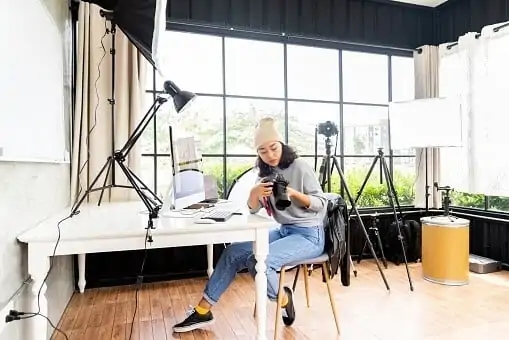The world of freelancing has been getting bigger and bigger. If you have skills behind a camera and you’re ready to go full-time, then you came to the right place. I’m going to tell you what it takes to make your side hustle into your full-time gig.
You’ll learn every step that goes into how to become a freelance photographer so you can leave your employer behind and become your own boss!
🚀 Kickstart Your Freelance Journey! 🚀
Discover the best platforms handpicked by our experts to supercharge your freelance career. Trusted by professionals worldwide, these platforms are essential for every freelancer.
Dive into a curated list of premium remote and flexible jobs. No scams, just genuine opportunities.
Explore FlexJobs
Say goodbye to endless job hunting. Receive top 1% of freelance jobs in your inbox.
Discover SolidGigs
With advanced AI, get matched with jobs that resonate with your skills and passion.
Join ZipRecruiter
Connect with global clients, showcase your portfolio, and bid on projects that align with your expertise.
Start on TopTal
How to Become a Freelance Photographer
The first step in making photography your full-time gig is to get started. If you have photography skills and equipment, you just need to be connected with the right people. For beginners, there are plenty of ways to start making real money.
If you already have skills in photography, you’re off to a good start. I always tell people to reach out to their friends and family. Ask them if they have a need for a freelance photographer.
Not only does it give you a better idea of how to become a freelance photographer, but it gives you a low-stress environment to learn how to work directly with a client rather than starting in a place like Solidgigs.
Finding friends for your initial projects will also result in some great feedback and testimonials to help your business. Remember, when you’re a freelancer you need to approach your work like it’s your business.
The same is true if you’re looking into how to become a freelance photojournalist. This is a little trickier unless you know the right people.
There are different ways to sell your skills online, and all you need is a bit of research to enlighten you about it.
How to Become a Freelancer Online
If you want to quickly grow your portfolio and learn the ropes, then you can try an online platform. Getting jobs online is not as hard as beginners think they are.
There are also easy freelance jobs that one can consider if you just get started in the freelancing world.
The best way to learn how to become a freelance photographer is to join a platform like Flexjobs or Fiverr. They are platforms that automatically connect you with clients who are willing to pay for your work.
If you have more experience, then you can apply for Solidgigs. They have higher-level clients that are looking for photographers that can do more.
There’s another site called Toptal that exclusively hires the top performers in different categories. If you have a very strong portfolio, you can try this site.
Don’t wonder anymore about how to become a freelancer online, it’s really as easy as signing up and getting started. There will be a learning curve in the beginning, but that’s to be expected with this line of work.
You’ll be a natural in no time. The advantage of online work is you can get connected with tons of people who are looking for your specific expertise.
See Related: Freelance Business Ideas for Self-Employment
The Tips and Tricks to Full-Time Freelance Photography

I’d like to take some time and explain in detail how to become a freelance photographer when you’re currently working a 9-5 office job.
These are some tips and tricks that I’ve come up with over the years, and I hope they help you! Keep in mind, these tips are in no particular order.
#1: Decide What Type of Photography
Think about how many different types of photography there are. Art, weddings, photojournalism, real estate, destinations for travel, marketing, landscapes, promotional – the list goes on. So now it’s time to decide what type of photography you want to offer.
If you use a site like Fiverr, you can experiment with different types of photography and find out which is right for you through trial and error.
Maybe you already have a portfolio of some projects of a certain type. This will help you get work in this type of photography, but it can also be used to pivot to another category if you want.
Also, keep in mind that learning how to become a freelance photojournalist follows a different path than a standard photographer. You’ll be reaching out to more specific clients, and you’ll also need journalistic knowledge.
Once you get the hang of it in photography and you have the passion for doing it, you might think of getting into a business eventually using your skills.
#2: Don’t Forget to Take Time Off
There is a common ploy that a lot of freelancers fall into. We work as hard as we can for as long as we can without any breaks. The result? We burn out.
I always suggest that you remember to take time off. After a big project, I always like to take a week or so and gather myself. Between projects, I might take a day or two.
Taking time off will net you more money each year because you won’t burn out and give up.
See Related: Best Freelance Books
#3: Get Good Equipment
In the world of photography, you can only be as good as your equipment. Make sure you have the right camera, lighting, lenses, and bodies.
There’s a lot that goes into taking photography for aspiring freelancer ideas which you probably know by now).
#4: Make a Great Website
If you don’t have a great website, you need to make one. It’s a way to show potential customers how great you are, and it also attracts new customers organically.
A good website will highlight your skills, tell your story, and tell potential customers how they can work with you. Don’t be afraid to spend a little on a designer and website builder to get this right.
See Related: How to Be a Freelance Illustrator
#5: Make it Legal
Each city and state have certain requirements when it comes to operating a freelance photography business legally. You want to make sure you check all the boxes, so you don’t run into legal problems later.
This might also be a good time to get some insurance out on your business and equipment.
See Related: How to Register as a Freelancer?
#6: Approach it Like A Business
This is the most meaningful advice I can give people on how to become a freelance photojournalist or photographer. Running a successful profile on Flexjobs is just like running a successful business. When you’re a freelancer, you’re running a business.
Everyone you work with is a client and therefore your boss, everything you get paid for is a project, and your name is a company name. You need to make sure you understand that this isn’t a hobby anymore and treat the work accordingly.
If you take the work seriously, you’ll get more serious work.

#7: Make a Routine
Just like a day in the office, you need to put together a routine that works for you. Over time, clients are going to learn when they can contact you same as other starting freelancers, when you might reach out to them, and when to expect their photos.
Since you’re going to be treating photography like a business, you might as well put together some business hours.
In those hours, you have to decide how much time you can dedicate to different tasks. I have a set routine that I’ve been following for a long time now. Now, my body and brain are used to it and the days flow by smoother.
It creates more predictability and professionalism on your part.
See Related: Best Freelance Graphic Design Websites
#8: Work Smart
Just because something is hard and takes a while to do it manually doesn’t mean you have to.
There are a million different programs that are designed specifically to expedite different things. People who made in the world of freelancing give thanks to the different apps and software they used.
My tip is to work smarter, not harder. If there’s a program you can use that automatically logs your time, creates invoices, and keeps track of your project – use it!
Understand how much money it can save you and compare that to how much it costs.
If it works out to less than your billable hourly rate, then go for it. The more autonomous your workflow is, the more money you can make and the more clients you can handle.
This is one of the things that you’ll perfect along the way. You might start out doing everything by hand, but eventually, you’ll understand where programs fit into your business.
See Related: Best Freelance Graphic Design Websites
#9: Build Your Portfolio
I cannot stress this enough – build your portfolio! Any time you take a professional picture, throw it on the portfolio. Add tags so someone viewing can sort your work by specifics. For example, put all of your landscape photos in the same part of your site, and your wedding photos in a different part.
Your portfolio should be easy to access for prospective clients and land a project. A lot of people like to put their portfolio on their website which also leads to more views on their site.
Also, it’s worth mentioning that your portfolio doesn’t have to be filled with photos you took strictly for clients. You can take your own pictures for the sole purpose of putting them on your portfolio.
Make sure all of the photos are professional and look incredible. This is the best way to promote your photography skills.
#10: Edit Before Delivering Photos
Every photo that you deliver to a client, send out, or put on your portfolio should be fully edited. You already know how important the editing process is, so you might as well show it off here.
People are used to the edited pictures they see online all the time using freelance editing sites, so they might be underwhelmed when you give them raw photos. Of course, if your client specifically asks for raw photos then you can provide them as well. Even when clients request unedited photos, I like to give them the edited versions as well so they can see the difference moving forward.
This is a good time to point out how important your editing skills are.
The best photographer in the world who has no editing skills might lose out to a mediocre photographer with the best editing skills.
Keep that in mind as you’re building your freelancing business.
Understand that your clients aren’t going to be professional photographers so they might not appreciate the photography tricks you used to take a great, unedited photo.

#11: Keep Learning
You can never learn too much. I spend a lot of time each year going to workshops, reading articles online, and doing research. There are a lot of online courses that will help you tremendously.
You’ve seen how quickly the world of photography has advanced. If you go years without learning anything new about photography, who’s to say how much you missed out on?
Learning and further education should be one of the most important things on your list as a freelance photographer.
Keeping up with the newest techniques and styling is a surefire way to improve your performance.
#12: Get Feedback, Testimonials, and Reviews
Everybody likes to work with a proven professional. That’s why we check reviews before going to a restaurant or buying an item online. We like to hear what other people have to say so we’re not going in blind.
Sure, your portfolio and website will give the viewer a good idea of your skill level.
Keep in mind, skill is just one part of picking out a photographer. They also want someone who’s easy to work with, punctual, professional, and always tries their best.
You can try to convince them that you have these qualities, but nothing’s more convincing than legitimate testimonials and reviews from past clients.
At the beginning especially, every time you close a project you should ask for feedback, a testimonial, and a review. It helps you understand how you performed. It also gives you insight into what you excel at and what you need to work on.
See Related: 12 Best Freelance Courses to Learn Online
#13: Connect with Other Photographers
Talking to people in the industry is a cool way to learn about different things you didn’t know about. Especially when you first start as a freelancer, your best friends should be fellow freelancers. They’ll know where to start, what to do, and some other personalized tips on how they found success.
If they ever get approached for projects that they don’t have the expertise or time to complete, ask them to forward the client to you.
Make sure you return the favor by doing the same for them.
#14: Take Time to Reflect
Every so often you should pause for a moment and reflect on your progress. Think about where you were a month, a year, or five years ago in your career. You might even take a look at some photography that you took back then and conversations with past clients.
This will give you a good gauge of how far you’ve come. This is a good way to avoid burning out because it shows you exactly what the outcome is of hard work and determination.
This is proof that you successfully found out how to become a freelancer online. This might be a good time to celebrate your triumphs, too.
See Related: Best Jobs Where You Work Alone
#15: Don’t Forget to Brag to Friends
Finally, don’t forget to brag about the success that you’ve found! Obviously, try not to do this with clients because it will paint you in a negative light.
Reach out to close friends and family and give them an update on a big project you got, great feedback from a client you received, or a new skill that you learned in the industry. Show off your portfolio to your friends and let them share your excitement!
It’s really fun to be a freelancer. Friends and family members that aren’t freelancers won’t get it and they’ll be so excited that you’re letting them behind the curtain a little bit.
Also, it helps you realize the good things going on in your career.
Related Articles
- Best Freelance Skills to Learn
- How to List Freelance Work on LinkedIn
- Easy Freelance Jobs for Beginners
Related Resources
